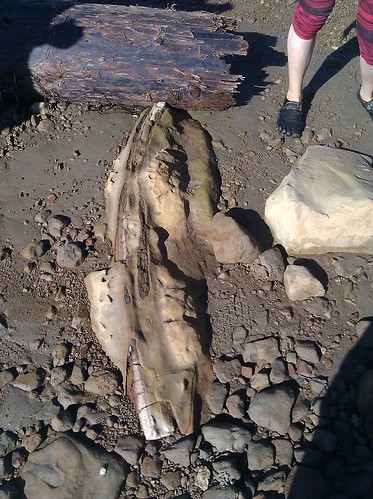Following the discovery of a new, natural whale fall in Antarctica (announced Wednesday), I entertained a brief obsession with marine snow and the communities that build up around whale falls. It is amazing how a whale carcass can support such a totally unique and vibrant community for 70 years or more. Of course it makes sense; since the sea floor is such a low-energy zone and there is a lot of food to be had on a whale.

Whale falls are incredibly difficult to find, because you must stumble upon the site of a whale carcass on the ocean floor entirely by chance. The deep sea floor is incredibly difficult to explore, and so the chances of finding a felled whale carcass get lower and lower the deeper it sinks. This is why most of what we know about whale fall communities come from “artificial” whale falls, or whale carcasses which scientists sink and then study the progression of the community which arises.
One of the weirder species which associates with whale falls is the Osedax, or bone eating worm. There is incredible diversity within the Osedax genus, so some scientists claim that it cannot feed on whale bones alone. However, nobody is quite sure what else Osedax eat when they’re not eating whale bones. The female worms use acid to bore into the whale bones and get at the plethora of lipids inside; while the male worms are microscopic – living inside of the lumen of the females. The females collect harems of these microscopic males and keep them inside of their bodies to fertilize their eggs frequently.
Another species that is said to associate with whale fall sites is the famous sleeper shark. You may have heard of the shark that they eat in Iceland after fermenting, since it is too toxic to eat fresh. Well, this is that shark. The toxicity comes from all the antifreeze inside the animal, required to keep it alive in low temperatures and under high pressures. The name sleeper shark comes from its incredibly slow speed – a result of the freezing cold waters it calls home. Scientists tagged the fins of sleeper sharks to see whether they were ever capable of bursts of speed, and found that they never seem to speed up. They live their entire lives going excruciatingly slow. Therefore, they are thought to eat sleeping seals (arctic seals are known to sleep in the water to avoid predation by polar bears). It makes sense, then, why sleeper sharks would like to hang out around whale carcasses.
After coming home on Wednesday I babbled like a lunatic about deep sea species and how little we know about them. Somewhere in the course of all this, I discovered that Doc had never heard about the infamous fate of male angler fish (not a whale fall associated species, of course, but still a pretty wacky alien-like deep sea creature). After describing the life cycle of a male angler fish to him, he simply said to me:
It would be wonderful if I could be absorbed into your skin just like a male angler fish.
I often think that the deep sea is far wackier than outer space could ever be.

One thought on “Whale Fall”